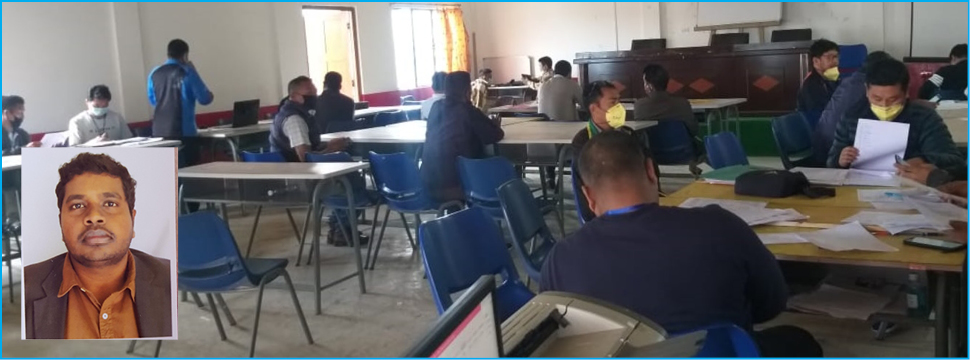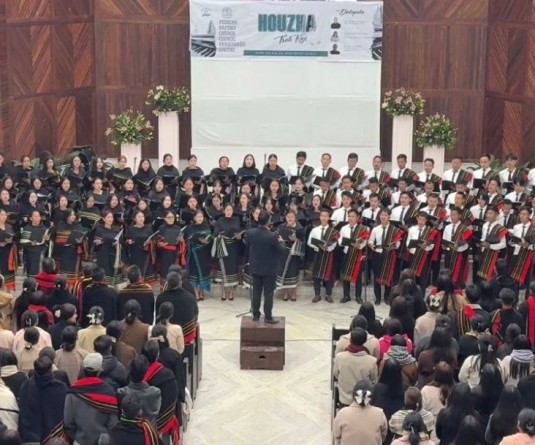1

The ‘COVID-19 War Room’ in Mon district headquarters. Four Sub-Divisional War Rooms have also been setup in Tobu, Aboi, Tizit and Naginimora to function as an auxiliary and operate in tandem with the District ‘War Room. (Inset) Mon Deputy Commissioner Thavaseelan K .
Morung Express News
Dimapur | April 22
Despite limited resources in terms of health infrastructure and other amenities, the Mon district response to current COVID-19 crisis has been steps ahead of the others, including the state government.
The District Administration and other authorities, particularly led by Mon Deputy Commissioner Deputy Commissioner Thavaseelan K, introduced a slew of measures and arrangements which were followed suit by others subsequently.
‘War-Room’ in place before state
For starters, even before the suggestion by the Nagaland Governor RN Ravi on April 14, COVID-19 ‘War-rooms’ were in place both at the district headquarter as well as other administrative divisions.
According to reports, the administration established a District ‘COVID-19 War Room’ on April 10.
Four Sub-Divisional War Rooms have also been setup in Tobu, Aboi, Tizit and Naginimora to function as an auxiliary and operate in tandem with the District COVID-19 War Room, DC Thavaseelan told The Morung Express.
“The War Room acts as a single point for information collection in addition to monitoring people under quarantine on a daily basis,” he informed.
It may be mentioned that the after Governor’s suggestion on April 14, a state-level multi-department – “COVID-19 War Room” under the Chief Secretary of Nagaland was created.
Subsequently, on April 21, Chief Secretary Temjen Toy also directed all the Deputy Commissioners to set up District ‘COVID-19 War Rooms’ to ensure effective and holistic response to the crisis.
Active Case Search, collection kiosk
Even though the district has not had a single positive case of COVID-19, the District War Room adopted an ‘Active Case Search’ strategy on April 13 to prevent and contain the outbreak throughout the district, Thavaseelan informed.
To carry out the exercise, 891 teams comprising of village or ward level task forces, ASHAs, ANMs, Anganwadi workers and teachers were formed.
Under this, each ward/village was divided into units of 50 households based on the recently concluded economic census, and a team of two conducted surveys on symptoms, travel history, contact with infected people, and so on.
Thavaseelan informed that the data collection for each and every single household in Mon district was completed on April 17.
“Presently, the data is being analyzed and catalogued by the district surveillance team and the District War Room. Once the analysis is done, we will proceed with testing based on the result of the analysis,” he said.
In addition to the Active Case Search, the ‘War Room’ has also been training various team members and volunteers and devising contact listing and cluster containment strategies in preparation for further course of action, he added.
In addition to these, Mon district is also the first in the state to install a walk-in sample kiosk (WISK) at District Hospital Mon to collect samples from those with COVID-19 symptoms.
On this, Thavaseelan said that the kiosk which was installed on April 20 was set up to minimize the risk of infection for healthworkers as well as to rationalize the use of personal protective equipment.
The district also adopted the ‘Cluster Containment Strategy’ focusing on strict implementation of the complete lockdown of a particular area, social distancing measures, enhanced active surveillance of people residing in that area, testing of all suspected cases, isolation of cases, quarantine of contacts and intensive risk communication to create awareness among public on preventive health measures.
‘Local Greens’
Another measure taken up by the District Administration is the ‘Local Greens’ project.
The District Administration collaborated with the Hills Area Development Organisation (HADO) and a local church to deliver fresh vegetables at home with a minimal delivery charge of Rs 10.
The vegetables and fruits directly collected from 150 farmers from 23 villages identified by the District Administration and delivered to the people.
According to the DC, this arrangement eliminates middle-men and not only enables farmers to earn regularly but also gets food to consumers at the usual market prices. In addition to that, restriction on movement is maintained and it is a win-win situation for everyone, he said.
Similarly, the administration in Aboi sub-division has also tied up with Nagaland State Rural Livelihoods Mission and Aboi Town Baptist Church Youth to home deliver local organic produce.
All the vegetables are procured from Self-Help Groups in Langmeing, Chaoha and Chinglong villages.
Similar initiatives are being adopted in other districts thereafter.
Banking services
To facilitate access to banking facilities, the District Administration coordinated with the Lead Bank Office and permitted teams from India Post Payment Bank (IPPB) and Banking Correspondent (BC) Customer Service Point (CSP) Representatives of State Bank of India to visit villages and facilitate the withdrawal of cash.
Village heads were entrusted with maintaining social distancing queues.
For those in the district headquarter, two mobile ATMs were also introduced on April 20 with each ATM making scheduled stops in every ward in the town.




